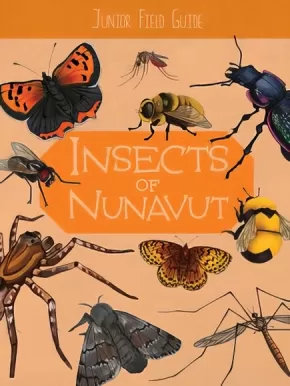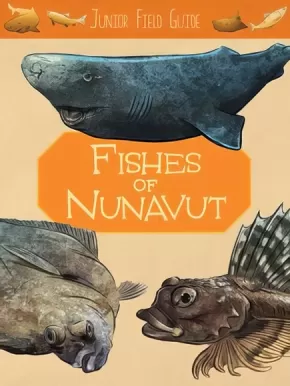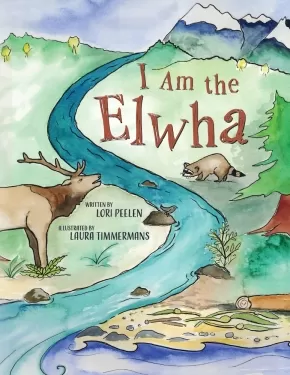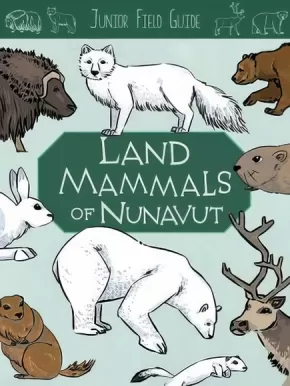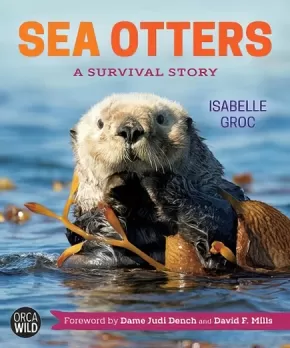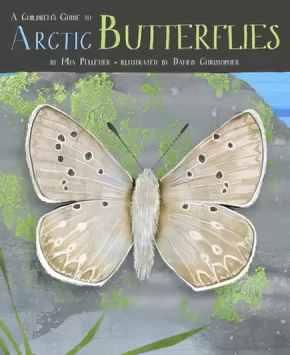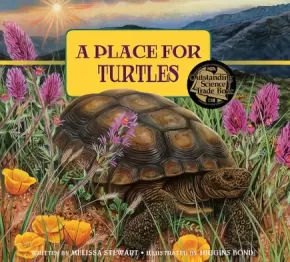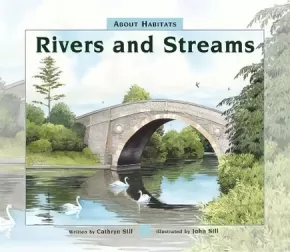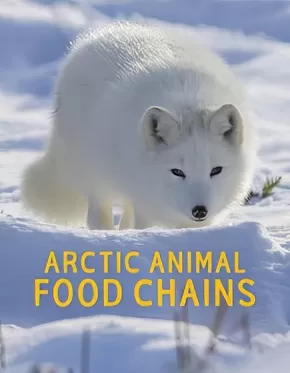
Ecosystem
46
-
60
of
92 Results;
Sort By
Go To
of 7
Forest Magic: A Guidebook for Little Woodland Explorers
$16.95
Artists:
Format:
Hardcover
ISBN / Barcode: 9781771089265
Synopsis:
Synopsis:
A beautifully illustrated, compact, interactive nature guide to exploring the forest for young readers.
What do you notice when you walk in the forest? Different types of trees, plants, and mushrooms? Maybe you hear a squirrel chattering or birds singing. Can you feel all the different kinds of moss? And look there! Hidden animal homes and interesting bugs.
With this compact non-fiction guide, young readers will be equipped to seek out, identify, and appreciate the woodland magic that exists all around them. Featuring rich vocabulary words like "nurse log," "lichen," and "sapling," this beautifully illustrated book is the ideal companion for little forest explorers. Incorporating all five senses and encouraging imaginative play, it even includes pixies and fairies (pixie cup lichen and fairy slipper wildflowers)! Forest Magic will be the book you reach for on the way out the door to explore your own backyard.
There's so much to see in a forest. What will you discover?
Educator & Series Information
Recommended for ages 4 to 8.
This book is part of the Little Explorers Series.
Additional Information
32 pages | 8.00" x 6.50"
Humongous Fungus
$21.99
Artists:
Format:
Hardcover
ISBN / Barcode: 9780744033335
Synopsis:
Synopsis:
Inhabiting a whole kingdom of their own, fungi can be found in every ecosystem.
They carpet the forest floor, and hidden fungi decompose matter, feed plants, and affect how animals function.
Their beautiful mushrooms come in all colors, shapes, and sizes. Fungal stories include the greening of the Earth, when fungi helped plants first grow on land, and the mass destruction of crops through fungal disease. From the villains of the possible extinction of bananas to plastic-eating eco-warriors, there are more than 1.5 million fungus species, and a huge, unknown number of unnamed "dark" types. They affect other creatures, too, for example by helping break down food, or controlling their minds against their will.
Continuing from the gorgeous Under Your Feet, and touching on similar topics of conservation and the secret processes within ecosystems, this book of fabulous fungi will intrigue and amaze young readers.
Educator Information
Recommended for ages 7 to 9.
Additional Information
64 pages | 9.00" x 11.00" | Hardcover
Insects of Nunavut
$12.95
Artists:
Format:
Paperback
Text Content Territories:
Indigenous Canadian; Inuit;
ISBN / Barcode: 9781774504741
Synopsis:
Synopsis:
There are lot of different types of insects in Nunavut. Learn about what defines an insect, as well as their life cycle, metamorphisis, and adaptions. This science book provides information about what different insects look like, where they live, what they eat, their behaviour, and other interesting facts about them, along with colourful illustrations and photographs.
Educator & Series Information
Recommended for ages 8 to 10.
This book is part of the Junior Field Guide series. Perfect for learning all about living things in the Arctic! These Junior Field Guides give information and interesting facts about the different animals that live in Nunavut. Books in this series also share traditional knowledge about living things and teach the traditional Inuit value of environmental stewardship.
Additional Information
32 pages | 10.00" x 7.50" | Paperback
The Frog Mother
$23.00
Artists:
Format:
Hardcover
Text Content Territories:
Indigenous Canadian; First Nations; Gitxsan (Gitksan);
ISBN / Barcode: 9781553799016
Synopsis:
Synopsis:
To the Gitxsan of Northwestern British Columbia, Nox Ga’naaw is a storyteller, speaking truths of the universe. After Nox Ga’naaw, the frog mother, releases her eggs among the aquatic plants of a pond, the tiny tadpoles are left to fend for themselves. As they hatch, grow legs, and transform into their adult selves, they must avoid the mouths of hungry predators. Will the young frogs survive to spawn their own eggs, continuing a cycle 200 million years in the making?
Book four of the Mothers of Xsan series follows the life cycle of the Columbia Spotted Frog. Learn about why this species is of special significance to the Gitxsan and how Nox Ga'naaw and her offspring are essential to the balance that is life.
Reviews
"In his engaging book, Hetxw'ms Gyetxw enhances plain biological facts by putting them in their cultural context; for example, the Frog Mother reflects the Gitxsan Nation’s matrilineal system. Donovan provides wonderfully sinuous illustrations that deftly capture frog movement and utilize color." — Kirkus Reviews
Educator & Series Information
Recommended ages: 9 to 12
This is the fourth book in the Mothers of Xsan series, which uses striking illustration and lyrical language to bring the poetry of the Xsan ecosystem to life. The traditional Gitxsan formline art and language weave together throughout the stories in this series to paint a vivid picture of the Gitxsan people.
Mothers of Xsan is a collection of stories that connects the world to the matrilineal society of the Gitxsan people, located in the Pacific Northwest Interior of British Columbia. Each book in the Mothers of Xsan series showcases the depth and importance of the knowledge that has been gathered and shared through this unique style of storytelling. The stories of life cycles, connection to the land, and language are told from the perspective of the animals from the Gitxsan’s traditional territory.
The series presents scientific knowledge in language and a format that is accessible.
Additional Information
32 pages | 6.50" x 10.00"
The Wolf Mother
$23.00
Artists:
Format:
Paperback
Text Content Territories:
Indigenous Canadian; First Nations; Gitxsan (Gitksan);
ISBN / Barcode: 9781553799788
Synopsis:
Synopsis:
Follow along as award-winning author Hetxw’ms Gyetxw (Brett D. Huson) introduces young readers to a pack of gray wolves. New pups have just begun to open their eyes, one of which is a striking black female. Every day, her ears grow larger, her eyesight gets sharper, and her legs stretch farther. As she learns to hunt, play, and run with her pack, instinct pulls her to explore beyond her home territory. Will the young wolf’s bold spirit help her find a new pack of her very own?
Learn about the life cycle of these magnificent canines, the traditions of the Gitxsan, and how gray wolves contribute to the health of their entire ecosystem.
Educator & Series Information
Recommended ages: 9 to 11
This is the fifth book in the Mothers of Xsan series, which uses striking illustration and lyrical language to bring the poetry of the Xsan ecosystem to life. The traditional Gitxsan formline art and language weave together throughout the stories in this series to paint a vivid picture of the Gitxsan people.
Mothers of Xsan is a collection of stories that connects the world to the matrilineal society of the Gitxsan people, located in the Pacific Northwest Interior of British Columbia. Each book in the Mothers of Xsan series showcases the depth and importance of the knowledge that has been gathered and shared through this unique style of storytelling. The stories of life cycles, connection to the land, and language are told from the perspective of the animals from the Gitxsan’s traditional territory.
The series presents scientific knowledge in language and a format that is accessible.
Additional Information
32 pages | 6.50" x 10.00" | Paperback
Fishes of Nunavut (9 in Stock)
$12.95
Artists:
Format:
Paperback
Text Content Territories:
Indigenous Canadian; Inuit;
ISBN / Barcode: 9781774500521
Synopsis:
Synopsis:
There are lots of fishes in the Arctic!
Learn about the different types of fishes that live in Nunavut waters. This non-fiction science book provides information about what different types of fishes look like, where they live, what they eat, and other interesting facts about them, along with colourful illustrations and photographs.
Educator & Series Information
Recommended for ages 8 to 10.
This book is part of the Junior Field Guide series. Perfect for learning all about living things in the Arctic! These Junior Field Guides give information and interesting facts about the different animals that live in Nunavut.
Includes some traditional knowledge about the animals included.
Curriculum Connections: Supports science units on the natural environment and animals of the arctic.
Simpler, classroom-ready version of the adult book Common Fishes of Nunavut. Includes one spread per species, with information like where they live, what they eat, what they look like, and other facts. Includes a glossary of English biological terms at the back.
Additional Information
32 pages | 7.50" x 10.00" | Paperback
I Am the Elwha (HC)
 $18.50
$18.50

Artists:
Format:
Hardcover
Text Content Territories:
Indigenous American; Native American; Salish; Coast Salish; Klallam (Clallam); Lower Elwha Klallam Tribe;
ISBN / Barcode: 9781771744744
Synopsis:
Synopsis:
“I am the Elwha, rushing down to the sea. I am the Elwha, wild and free.”
The Elwha River flows 72 kilometres (45 miles) from its source in the Olympic Mountains to the Strait of Juan de Fuca in the Pacific Northwest. Uniquely, it hosts all six salmon species (Pink, Chinook, Coho, Sockeye, Steelhead, and Chum) as well as several species of trout.
In 1911 two dams were built on the river. The dams blocked the migration routes of the salmon and dramatically altered the entire river ecosystem for 100 years. In 2012 the dams were decommissioned and the world’s largest dam removal and habitat restoration project began.
In this lyrical and beautifully illustrated book, the author chronicles the history of the Elwha. Narrated by the powerful voices of plants and animals that inhabit the river ecosystem, the dam builder, a worker, and the river itself, this story celebrates the ongoing rewilding of this special environment and offers a welcome to all of the creatures who are coming home.
To learn more visit: www.elwha.org
Awards
- 2021 Riverby Award for Young Readers
Reviews
“I Am the Elwha is a powerful read about a powerful river and those who value and protect it." – Raina Delisle, Hakai Magazine
Educator Information
At the back of the book are three pages of cultural, scientific, and historical information that discuss the following:
- the importance and symbolism of salmon to the Lower Elwha Klallam Tribe and other Coastal Salish Tribes
- facts about the six species of salmon found in the Elwha River (Chinook, Pink, Chum, Sockeye, Coho, and Steelhead)
- the history of the Elwha River and its status today
Keywords / Subjects: The Elwha River, Rivers, Dams, History, Environmental Awareness, Lower Elwha Klallam Tribe, Coast Salish, Native American, Culture, Washington, Animals, Salmon, First Salmon Ceremony, Plants, Nature, Settlers, Social Responsibility, Environmental Activism, Poetry.
Recommended for grades 3 to 7.
Additional Information
32 Pages | 8.5" x 11" | ISBN: 9781771744744 | Hardcover
Authenticity Note: This lyrical story, which chronicles the history of the Elwha River, is written by Lori Peelen. Robert Elofson, Tribal Elder and Harvest Manager in the Natural Resources Department for the Lower Elwha Klallam Tribes, approved Lori's work and contributed a few pages of back matter at the end of the work. Lori's story was further approved by Frances Charles, the Tribal Councilwoman for the Lower Elwha Klallam Tribe, after the entire council read and approved it.
The Canadian Content label has been applied because the illustrator of this work is Canadian.
Land Mammals of Nunavut
$12.95
Artists:
Format:
Paperback
Text Content Territories:
Indigenous Canadian; Inuit;
ISBN / Barcode: 9781774500545
Synopsis:
Synopsis:
What do you know about Arctic land mammals?
From lemmings to polar bears, there are a lot of different types of land mammals living in Nunavut. This non-fiction science book provides information about what the mammals look like, where they live, what they eat, and other interesting facts about them, along with colourful illustrations and photographs.
Educator & Series Information
Recommended for ages 8 to 10.
This book is part of the Junior Field Guide series. Perfect for learning all about living things in the Arctic! These Junior Field Guides give information and interesting facts about the different animals that live in Nunavut.
Includes some traditional knowledge about the animals included.
Curriculum Connections: Supports science units on the natural environment and animals of the arctic.
Simpler, classroom-ready version of the adult books Terrestrial Mammals of Nunavut. Includes one spread per species, with information like where they live, what they eat, what they look like, and other facts. Includes a glossary of English biological terms at the back.
Additional Information
32 pages | 7.50" x 10.00" | Paperback
Sea Otters: A Survival Story
$24.95
Format:
Hardcover
ISBN / Barcode: 9781459817371
Synopsis:
Synopsis:
Sea otters back from the brink!
Sea otters once ruled the Pacific Ocean, but the fur trade of the eighteenth and nineteenth centuries brought this predator to near extinction. Today they’re slowly coming back from the brink, and scientists are learning more about their pivotal role as one of nature’s keystone species. This book looks at the history, biology, behavior and uncertain future of sea otters. Author and photojournalist Isabelle Groc takes us into the field: watching sea otter rafts off the British Columbia coast from a kayak, exploring what makes their fur coats so special, understanding how their voracious appetites are helping kelp forests thrive and, ultimately, learning how sea otters are leaving their mark (or paws) on every part of the ecosystem. They might be one of the most adorable creatures in the ocean, but kids will discover how their survival is key to a rich, complex and connected ecosystem.
Educator Information
Recommended for ages 9 to 12.
This book is part of the Orca Wild series, which explores the lives of the creatures with whom we share the world and asks readers to consider the effects -- both positive and negative -- that humans have on vulnerable animal populations and habitats.
Key Features:
- This book looks at the history, biology, behavior and uncertain future of sea otters, their journey from near extinction and how their role as a keystone species is essential to a rich, complex and connected ecosystem.
- Filled with the history and ecology of sea otters, this book will inform and inspire young readers to take action to help the conservation of sea otters.
- The author is a photojournalist whose stories and photos have appeared in National Geographic News, BBC Wildlife and Scientific American, and she has also produced videos for National Geographic.
- One of the world’s most beloved animals, 99 percent of sea otters were hunted to near extinction during the fur trade, and even though their numbers are coming back, they are still an endangered species.
- Includes a foreword from Dame Judi Dench and David F. Mills.
Additional Information
128 pages | 7.50" x 9.00"
The Boreal Forest: A Year in the World's Largest Land Biome
$19.99
Artists:
Format:
Hardcover
Text Content Territories:
Indigenous;
ISBN / Barcode: 9781525300448
Synopsis:
Synopsis:
Combining lyrical storytelling with expertly researched informational text, this beautiful book provides a year-long tour of the planet's largest land biome --- one of our most important wildernesses.
The vast boreal forest spans a dozen countries in the northern regions like “a scarf around the neck of the world,” making it the planet's largest land biome. Besides providing homes for a diversity of species, this spectacular forest is also vitally important to the planet: its trees clean our air, its wetlands clean our water and its existence plays an important role in slowing global climate change. In this beautifully written book, award-winning author L. E. Carmichael explores this special wilderness on a tour of the forest throughout the four seasons, from one country to another. Evocative watercolor and collage artwork by award-winning illustrator Josée Bisaillon provides a rare glimpse of one of the world's most magnificent places.
With excellent STEM applications in earth science and life science, this enjoyable book aims to foster environmental awareness of and appreciation for this crucial forest and its interconnections with the entire planet. In a unique approach, the text features a lyrical fictional narrative describing the wildlife in a specific part of the forest, paired with informational sidebars to provide further understanding and context. Also included are a world map of the forest, infographics on the water cycle and the carbon cycle, a glossary, resources for further reading, author's sources and an index.
This book has been reviewed by experts and was written in consultation with Indigenous peoples who live in the boreal forest region.
Educator Information
Recommended for ages 8 to 12.
Curriculum: Ecosystem; Environment; Animals; Habitats; Water
Reading Levels:
Guided Reading S
Guided Reading Grade Leve l4
Lexile Level 860
Keywords: environmental awareness, Canada, Russia, United States, trees, plants, science, nature, ecology, animals, wildlife, fun facts, curiosity, STEM books for kids
Contains some Indigenous content.
Additional Information
48 pages | 9.50" x 12.30"
The Eagle Mother
$23.00
Artists:
Format:
Hardcover
Text Content Territories:
Indigenous Canadian; First Nations; Gitxsan (Gitksan);
ISBN / Barcode: 9781553798590
Synopsis:
Synopsis:
Return to the valleys of the River of Mists with award-winning author Hetxw'ms Gyetxw (Brett D. Huson). Nox xsgyaak, the eagle mother, cares for her brood in the embrace of a black cottonwood with the help of her mate. Will both eaglets survive the summer in an environment that is both delicate and unforgiving?
Learn about the life cycle of these stunning birds of prey, the traditions of the Gitxsan, and how bald eagles can enrich their entire ecosystem. Evocative illustration brings the Xsan's flora and fauna to life for middle years readers in book three of the Mothers of Xsan series.
Reviews
“The Eagle Mother by Hetxw’ms Gyetxw (Brett D. Huson) and illustrator Natasha Donovan, the third in the Mothers of Xsan series, which offers a perspective on the life cycle of animals important to the land and to people.”— Publishers Weekly
"For further learning about the Gitxsan, the author has included a glossary titled "The Gitxsan Moons" and a summary of Gitxsan Nation clans" - Canadian Indigenous Books for Schools 2020/2021
Educator & Series Information
Recommended ages: 9 to 12 (Grades 3 to 7).
This is the third book in the Mothers of Xsan series, which uses striking illustration and lyrical language to bring the poetry of the Xsan ecosystem to life. The traditional Gitxsan formline art and language weave together throughout the stories in this series to paint a vivid picture of the Gitxsan people.
The Mothers of Xsan series is a collection of stories that connect the world to the matrilineal society of the Gitxsan people, located in Northwestern British Columbia. It presents scientific knowledge in language and a format that is accessible. Each book in the series showcases the depth and importance of the knowledge that has been gathered and shared through this unique style of storytelling. The stories of life cycle, connection the land and language are told from the perspective of the Mothers of Xsan system's animals.
Recommended in the Canadian Indigenous Books for Schools 2020/2021 resource list as being useful for grades 1-4 in the areas of Language Arts, Science, and Social Studies.
Additional Information
32 pages | 6.50" x 10.00"
A Children's Guide to Arctic Butterflies
$16.95
Artists:
Format:
Hardcover
ISBN / Barcode: 9781772271775
Synopsis:
Synopsis:
Most Arctic animals have warm, woolly coats or thick layers of blubber, but Arctic butterflies have only their fluttering, delicate wings. The hardy butterflies that live in the Arctic have had to find clever ways to keep themselves warm in cool summers and survive icy cold winters. In A Children’s Guide to Arctic Butterflies, young readers learn about twelve of the butterfly species that call the Arctic home and how they survive from one summer to the next.
With a simple layout and easy-to-follow headings for each butterfly, this beautiful book is filled with fun, useful facts, including introductory material about the life cycle and anatomy of butterflies and how they begin life as caterpillars.
Step inside and journey North—you may even spot a familiar fluttering friend!
Educator Information
Recommended ages 7-9.
Additional Information
32 pages | 9.00" x 8.00"
A Place for Turtles
$10.95
Artists:
Format:
Paperback
ISBN / Barcode: 9781682630976
Synopsis:
Synopsis:
Turtles outlived the dinosaurs, but today they are one of the most threatened species of vertebrae on Earth. How can we help?
In simple yet engaging language, acclaimed science writer Melissa Stewart showcases twelve types of North American turtles, from the familiar box turtle to the majestic loggerhead turtle. Her clear narrative shows the threats these turtles face, and informative sidebars describe a wide variety of efforts to save them. Featuring glorious full-color illustrations by Higgins Bond and range maps for each turtle, this is a perfect choice for budding scientists, environmentalists, and nature lovers.
Awards
- Green Earth Book Award (Nonfiction) / The Nature Generation
- NSTA Recommends / National Science Teachers Association
- Outstanding Science Trade Books for Students K-12 / NSTA / CBC
Reviews
“While the topic of the book is clearly turtles, the narrative…will get young minds thinking about the interconnectedness of organisms, ecology, and the impact of human actions on the world around them. A classroom-friendly blend of story and fact.” ―Booklist
“A perfect resource.” ―National Science Teachers Association
Educator Information
This nonfiction picture book is recommended for ages 6 to 10.
Additional Information
32 pages | 10.25" x 9.25"
About Habitats: Rivers and Streams (5 in Stock)
$16.95
Artists:
Format:
Hardcover
ISBN / Barcode: 9781682630914
Synopsis:
Synopsis:
This beginner's guide explores the major attributes of rivers and streams and showcases their remarkable diversity using examples of waterways from around the globe.
In this addition to the About Habitats series, award-winning author Cathryn Sill uses simple, easy-to-understand language to teach children what rivers and streams are and explain how various species of animals and plants have adapted to life in or along these waterways. John Sill's detailed, full-color illustrations show the characteristics of the world's different rivers and streams (from the mountain streams of the Alps to the mighty Amazon River in South America).
A glossary and afterword provide further fascinating details about rivers and streams to inspire readers to learn more.
Educator & Series Information
Recommended for ages 3 to 7.
This book is a part of the About Habitats series, which introduces children to specific habitats and their living and nonliving components.
Additional Information
48 pages | 10.25" x 8.75" | Hardcover
Arctic Animal Food Chains - Nunavummi Reading Series
$10.95
Format:
Paperback
ISBN / Barcode: 9781772669015
Synopsis:
Synopsis:
Learn about food chains in the Arctic!
This book explores the concept of the food chain using Arctic plants and animals.
Educator & Series Information
This book is part of the Nunavummi Reading Series, a Nunavut-developed series that supports literacy learning while teaching readers about the people, traditions, and environment of the Canadian Arctic. It is a Level 13 book in the series.
Nunavummi Reading Series books have also been officially levelled using the Fountas & Pinnell Text Level Gradient™ Levelling System. F&P Level of this book: O.
Curriculum Connections: Language and Literacy; Diversity; Environmental Awareness; Life Systems
Recommended for ages 7 to 9.
Additional Information
32 pages | 7.00" x 9.00"
Sort By
Go To
of 7




